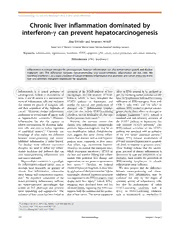
Chronic liver inflammation dominated by interferon-? can prevent hepatocarcinogenesis. PDF
Preview Chronic liver inflammation dominated by interferon-? can prevent hepatocarcinogenesis.
OncoImmunology1:2,222–223;March/April2012;G2012LandesBioscience Chronic liver inflammation dominated by interferon-c can prevent hepatocarcinogenesis Jörg Schrader and Johannes Herkel* DepartmentofMedicineI;UniversityMedicalCentreHamburg-Eppendorf;Hamburg,Germany Keywords: inflammation, regeneration, interferon, STAT, apoptosis, p53, cancer, tumor-promotion, anti-cancer immunity Abbreviations: IFNc, interferon-c Inflammationisamajorstimulusforcarcinogenesis;howeverinflammationcanalsoinhibittumorgrowthanddeplete malignant cells. The differences between cancer-promoting and cancer-inhibitory inflammation are not clear. We identifiedInterferon-casamajormediatorofcancer-inhibitoryinflammationthatpromotesanti-cancerimmunityinthe liverandsensitizes malignant hepatocytes for apoptosis. © 2012 Landes Bioscience. Inflammation is a critical promoter of activation of the NFkB pathway in liver effect of IFNc seemed to be mediated in carcinogenesis. Indeed, a characteristic of macrophages and the secretion of inter- part by increasing tumor immune surveil- most, if not all tumors is a microenviron- leukin-6, which, in turn, stimulates the lancebylymphocytes,indicatedbyastrong ment of inflammatory cells and mediators STAT3 pathway in hepatocytes and infiltration of IFNc-transgenic livers with that enables the growth of malignant cells enables the survival and proliferation of CD8 T cells, NKT and NK cells.8 In and their acquisitionDof the o‘hallma rkns of odamagted celdls.4,5 Iinflasmmattoryrlymiphbo- audditiont, IFeNc se.emed to prevent carcino- cancer’.1 Moreover, chronic inflammation cytes can also secrete STAT3-activating genesisalsobydirecteffectsondamagedor predisposes toseveraltypesofcancer,such cytokines,suchasinterleukin-22,thatmay malignant hepatocytes.8 IFNc induced a as hepatocellular carcinoma.2 However, further promote liver cancer.6 sustained and non-refractory activation of inflammation has also the capacity to However, the common notion that the STAT1 pathway in hepatocytes, but inhibit carcinogenesis by depleting malig- chronic liver inflammation unequivocally only transient STAT3 activation.8 This nant cells, and even to induce regression promotes hepatocarcinogenesis may be an IFNc-induced activation of the STAT1 of established tumors.2,3 Currently, our over-simplification.Indeed,clinicalobserva- pathway was associated with an activation knowledge of what makes the difference tions suggests that some chronic inflam- of the p53 tumor suppressor pathway.8 between tumor-promoting and tumor- matoryliverdiseases,suchasviralhepatitis, Indeed, IFNc induced accumulation of inhibitory inflammation is rather limited. progress more commonly to liver cancer p53andsensitizedhepatocytestoapoptotic To develop more effective anti-tumor than others; e.g., autoimmune hepatitis. cell death in response to genotoxic stress.8 therapies, we need to define key inflam- Moreover,wenoticedthattransgenicmice, These findings indicate that the carcino- matory mediators and pathways that can which overexpress interferon-c (IFNc) in genic potential of chronic inflammation is turn tumor-promoting inflammation into the liver and manifest lifelong liver inflam- determined by type and composition of its anti-cancerimmunity. mation with persistent liver damage and mediators, most notably the proportion of Hepatocellular carcinoma is a paradigm regeneration,are not prone to spontaneous IFNc-secreting lymphocytes in chronic for inflammation-induced cancer, since it liver cancer.7,8 Therefore, we induced inflammatorytissueinfiltrates. develops most frequently on grounds of chemicalhepatocarcinogenesisinthesemice We thus propose that the differences chronic liver inflammation, consecutive byapplicationofdiethylnitrosamine.8Quite between tumor-promoting and tumor- tissuedamageandcompensatoryregenera- surprisingly, chemical hepatocarcinogenesis inhibitory liver inflammation may be tion.2 An important component of the wassuppressedintheIFNc-transgenicmice explained not only by the degree of tumor-promoting inflammatory infiltrate despite overt liver injury.8 Indeed, IFNc- cytotoxic activity of inflammatory cells, are tumor-associated macrophages that transgenic mice developed fewer and less but also by predominance of either exhibit an M2 phenotype and promote advancedlesions,suggestingthatIFNcmay STAT1-activating cytokines, such as tissue remodeling and angiogenesis.2 The suppressboththeinitiationandthepromo- IFNc, or STAT3-activating cytokines, initiationoflivercancerhasbeenlinkedto tion ofliver cancer.The tumor-suppressive such as interleukin-6 or interleukin-22 *Correspondenceto:JohannesHerkel;Email:[email protected] Submitted:09/15/11;Accepted:09/15/11 http://dx.doi.org/10.4161/onci.1.2.18114 222 OncoImmunology Volume1Issue2 AUTHOR'SVIEW © 2012 Landes Bioscience. Figure1.Amodelofcancer-promotingandcancer-inhibitoryliverinflammation.Tumor-suppressiveinflammatoryliverinfiltratesarecharacterizedby highcontentofIFNc-secretinglymphocytes(Th1,CD8T,NKandNKTcells),sustainedactivationoftheSTAT1pathwayinhepatocytes,macrophage polarizationtowardanM1phenotypeandfibrolysis.Incontrast,tumor-promotingliverinfiltratesarecharacterizedbyhighcontentofIFNcnon- producingorinterleukin-22producinglymphocytes,interleukin-6secretionbyvariouscelltypes,macrophageswithM2phenotype,sustainedSTAT3 activationinhepatocyteDs,fibrogoenesisa ndnangiogoenesis.t distribute. (Fig.1). This model is compatible with whereas M2 macrophages, which are some NKT cells, may characterize tumor- thefindingthatthebalanceofSTAT1and induced by non-IFNc producing lympho- suppressive inflammation, whereas infil- STAT3 activation seems to predict the cytes and malignant hepatocytes, promote trates with high content of IFNc clinicaloutcomeincutaneousmelanoma.9 fibrogenesis and angiogenesis. It is con- non-producing or interleukin-22 pro- During tumor promotion, the presence ceivable that the presence of IFNc during ducing lymphocytes may characterize or absence of IFNc further influences tumor promotion may prevent induction tumor-promoting infiltrates. Therefore, the tumor microenvironment and tissue of M2 macrophages. In summary, inflam- manipulating the type of chronic inflam- remodelling.Indeed,IFNcisknowntopro- matory infiltrates with high content of mation and the composition of tumor- mote macrophage polarization toward an IFNc-secreting lymphocytes, i.e., Th1 associated inflammatory infiltrates may M1 phenotype and to inhibit fibrogenesis, cells, CD8 T cells, some NK cells and servetheprevention ofcancer. References 5. HeG,KarinMNF.-kBandSTAT3-keyplayersin 8. LüthS,SchraderJ,ZanderS,CarambiaA,BuchkremerJ, liverinflammationandcancer.CellRes2011;21:159- HuberS,etal.ChronicinflammatoryIFN-csignaling 1. HanahanD,WeinbergRA.Hallmarksofcancer:thenext 68; PMID:21187858; http://dx.doi.org/10.1038/cr. suppresses hepatocarcinogenesis in mice by sensitizing generation. Cell 2011; 144:646-74; PMID:21376230; 2010.183 hepatocytesfor apoptosis. CancerRes 2011;71:3763- http://dx.doi.org/10.1016/j.cell.2011.02.013 6. ParkO,WangH,WengH,FeigenbaumL,LiH,YinS, 71; PMID:21512142; http://dx.doi.org/10.1158/0008- 2. MantovaniA,AllavenaP,Sica A,Balkwill F. Cancer- etal.Invivoconsequencesofliver-specificinterleukin-22 5472.CAN-10-3232 relatedinflammation.Nature2008;454:436-44;PMID: expressioninmice:Implicationsforhumanliverdisease 9. WangW,EdingtonHD,RaoUN,JukicDM,Land 18650914;http://dx.doi.org/10.1038/nature07205 progression. Hepatology 2011; 54:252-61; PMID: SR,FerroneS,etal.Modulationofsignaltransducers 3. ZitvogelL,ApetohL,GhiringhelliF,AndréF,TesniereA, 21465510;http://dx.doi.org/10.1002/hep.24339 and activators of transcription 1 and 3 signaling in Kroemer G. The anticancer immune response: indis- 7. ToyonagaT,HinoO,SugaiS,WakasugiS,AbeK, melanomabyhigh-doseIFNalpha2b.ClinCancerRes pensable for therapeutic success? J Clin Invest 2008; ShichiriM,etal.Chronicactivehepatitisintransgenic 2007; 13:1523-31; PMID:17332298; http://dx.doi. 118:1991-2001;PMID:18523649;http://dx.doi.org/10. mice expressing interferon-c in the liver. Proc Natl org/10.1158/1078-0432.CCR-06-1387 1172/JCI35180 Acad Sci USA 1994; 91:614-8; PMID:8290572; 4. YuH,PardollD,JoveR.STATsincancerinflammation http://dx.doi.org/10.1073/pnas.91.2.614 and immunity: a leading role for STAT3. Nat Rev Cancer2009;9:798-809;PMID:19851315;http://dx. doi.org/10.1038/nrc2734 www.landesbioscience.com OncoImmunology 223
